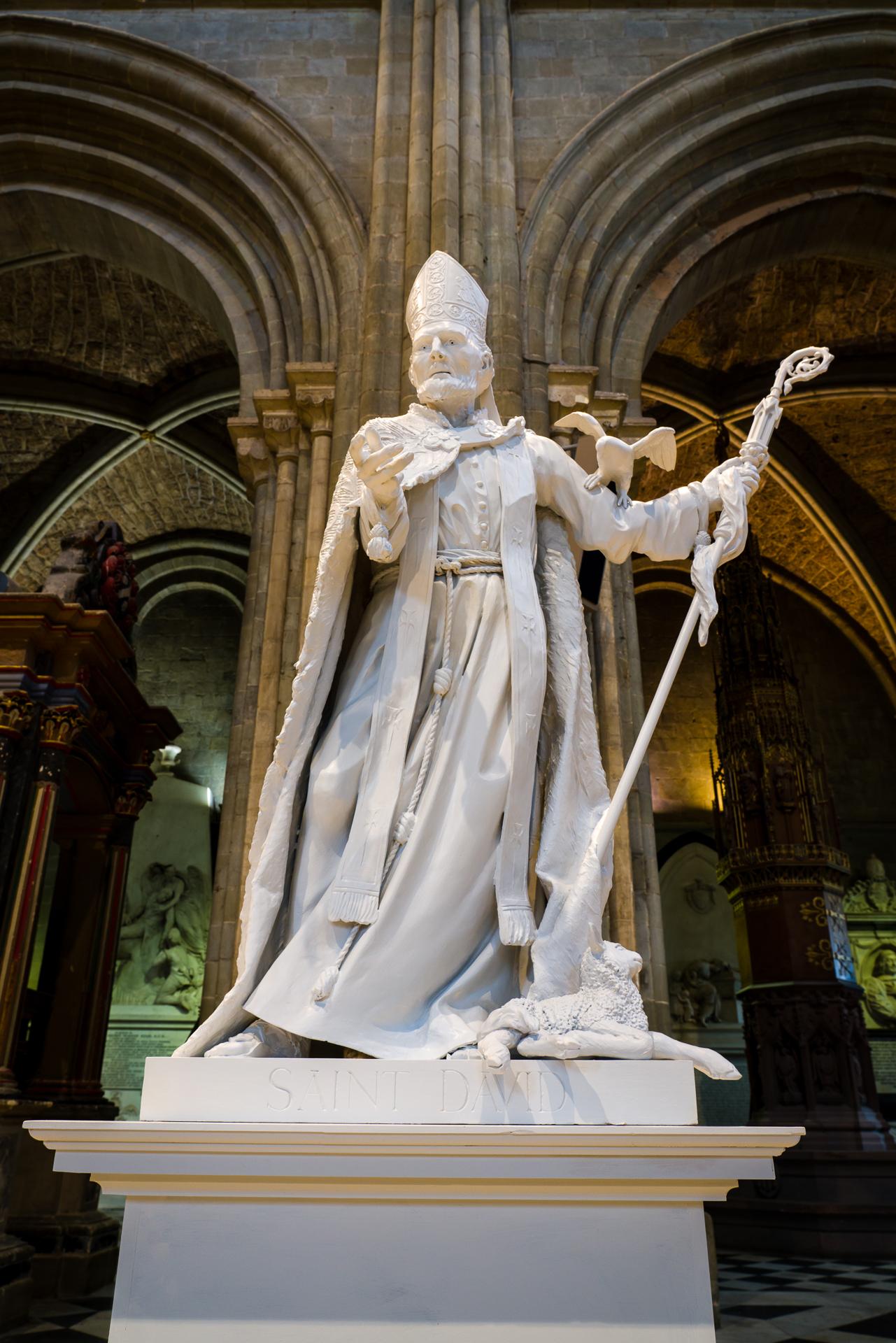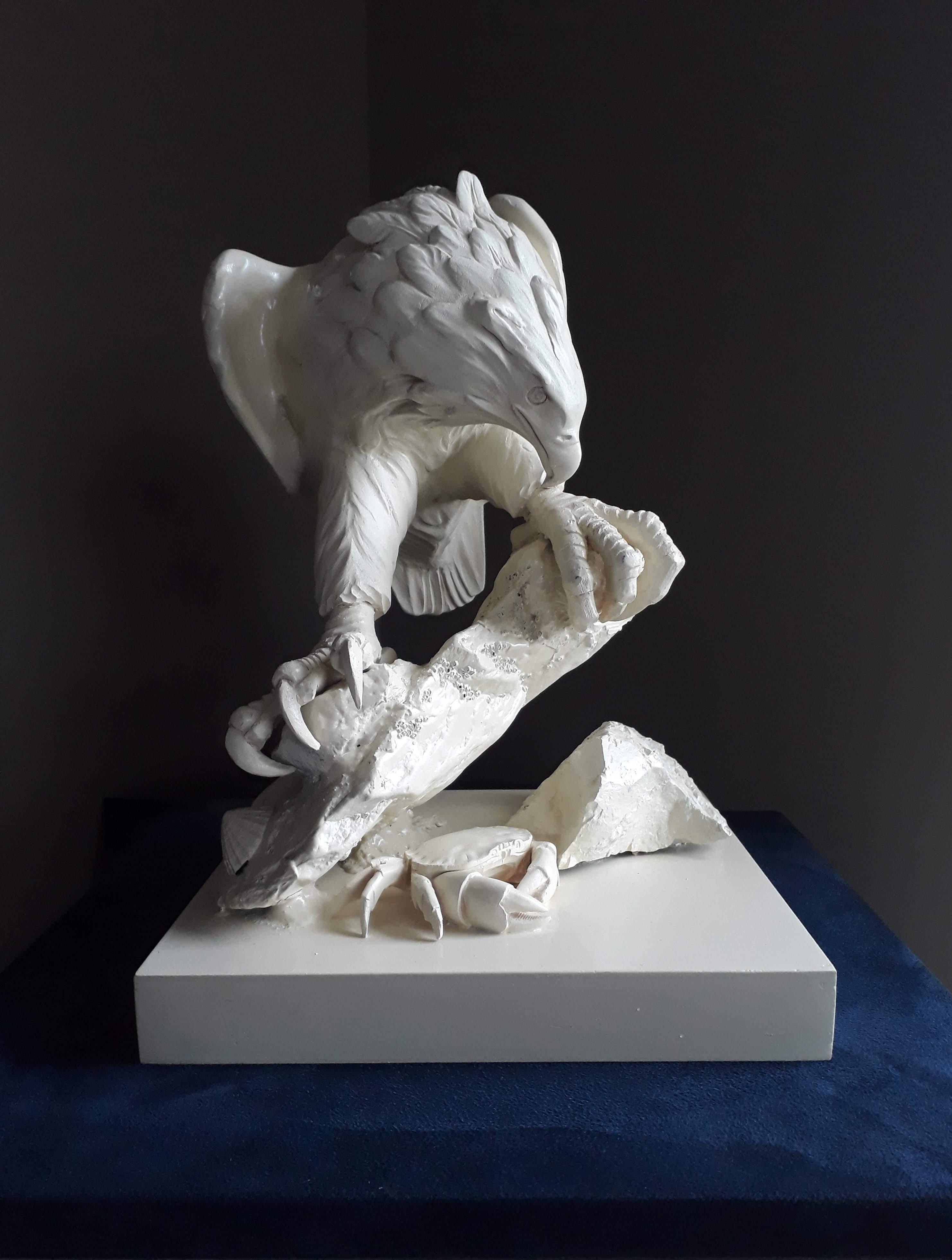Items Similar to Llewelyn ab Iorwerth (Llewelyn the Great)
Want more images or videos?
Request additional images or videos from the seller
Barry DaviesLlewelyn ab Iorwerth (Llewelyn the Great)2022
2022
About the Item
Llywelyn ab Iorwerth, (Llywelyn the Great) born in Dolwyddelan d.1240AD Aberconwy Abbey.
King of Gwynedd and Prince of Wales he dominated Wales for 45 years. In 1200 Llywelyn made a Treaty with King John and following John’s death in 1216 he concluded the Treaty of Worcester with John’s successor Henry III. Llywelyn married King John’s daughter Joan lady of Wales. Davies' depiction of this 13th century leader in this statue is based on thorough and extensive research, modelled in plaster it shows a variety of elements from his leather boots to his crown and sword all true to the period and yet to be cast in bronze. Llywelyn stands here defiant and strong with a greyhound by his side, high on the Gwynedd mountains, now Snowdonia. Davies made a mould of a rocky outcrop on the Snowdonia mountains between Dinas Mawddwy and Bala earlier last year, then cast the mould and incorporated it into the statue itself. The statue you see in the images is a painted plaster model, the price quoted is for the same statue but cast in bronze. It can be patinated white for indoor placing only but darker colours for outdoor or indoor placing. A modern minimalist plinth 76cm high is an optional extra at £6,000 made from a stainless steel subframe clad in Carrara marble.
- Creator:Barry Davies (1962, British)
- Creation Year:2022
- Dimensions:Height: 88.59 in (225 cm)Width: 30.71 in (78 cm)Depth: 26.78 in (68 cm)
- Medium:
- Movement & Style:
- Period:
- Condition:
- Gallery Location:Oswestry, GB
- Reference Number:1stDibs: LU2437211998452
Intrinsically artistic and previously trained as a precision engineer Barry Davies started up a small business in 1989 as a cabinet maker. He introduced carving to embellish the furniture which proved popular with clients. The carving rapidly developed to sculpture and realising the need to extend his knowledge of the traditions of sculpture, Davies studied Art History with the Open University. He developed the use of the golden ratio to proportion his works as did renaissance sculptors Donatello and Michelangelo. He has sculpted portrait busts of Julius Caesar, Shakespeare and many others from solid Cararra marble blocks imported from Italy. He also sculpted a statue of 16th century Bishop William Morgan who translated the Bible from Hebrew into Welsh. Davies' passion for anthropology, palaeontology and anatomical study has led him to not only create bronze sculptures but also tutoring classes in clay modelling of these subjects. Since 2010 Davies has exhibited his sculptures in the UK and Europe. The international exhibitions include venues in Chelsea, London,- Uffizi gallery, Florence, - Bramante Halls, Rome,- Flangini Palace, Venice - Milan - Verona and Barcelona. Davies now creates 3/4 life-size statues of historical figures namely St.david, Llywelyn ap Iorwerth (Llywelyn the Great) ,a thoroughbred horse and the Coronation of Henry V. He was a member of a panel of judges of the prestigious ‘Visual Art Open’ in Chester, UK. Davies' sculptures are the culmination of decades of study of human and animal anatomy, classical, renaissance and Baroque sculpture creating his own unique style in figurative statuary and depicting natural history in bronze.
About the Seller
5.0
Vetted Seller
These experienced sellers undergo a comprehensive evaluation by our team of in-house experts.
Established in 1989
1stDibs seller since 2023
Typical response time: 1 hour
- ShippingRetrieving quote...Ships From: Oswestry, United Kingdom
- Return PolicyA return for this item may be initiated within 14 days of delivery.
More From This SellerView All
- Saint DavidLocated in Oswestry, GBThis statue of Saint David, the Patron Saint of Wales stands 150cm high and is depicted with historical accuracy. Davies created this statue following extensive and thorough research...Category
2010s Baroque Figurative Sculptures
MaterialsBronze
- White tailed sea eagle and crabLocated in Oswestry, GBThis white tailed sea eagle is depicted here on a rock on the shore of a remote wild Scottish Isle (Outer Hebrides). Hiding beneath the rock is a brown crab...Category
16th Century Baroque Figurative Sculptures
MaterialsBronze
- LambLocated in Oswestry, GBThis lamb is also featured in my statue of Saint David. It conveys such character and gentleness that I decided to present it as a sculpture in its own right. I lays on a base of bla...Category
2010s Baroque Figurative Sculptures
MaterialsMarble, Bronze
- Perseus and Fame proclaiming the birth of PegasusLocated in Oswestry, GBThis neo-classical style sculpture is of Perseus the son of Zues and Danae is ordered by King Polydectes to slay the gorgon Medusa. With the gift of a polished shield from Athena, a ...Category
Early 17th Century Baroque Figurative Sculptures
MaterialsBronze
- Discus Thrower's TorsoLocated in Oswestry, GBThis artwork emulates the classical statues from the ancient world, particularly with the head broken off at the base of the neck if carved in marble. In fact I went to the lengths o...Category
17th Century Baroque Figurative Sculptures
MaterialsGranite, Bronze
- GreyhoundLocated in Oswestry, GBWhat is unique about this artwork is the grace and elegance of the greyhound but designed in a most difficult stance frought with technical challenges. Yet the result offers a stance...Category
Early 17th Century Baroque Figurative Sculptures
MaterialsBronze
You May Also Like
- 19th Century French Bacchanalian BronzeLocated in San Antonio, TX19th Century French Bacchanalian Bronze in the 18th century style depicting two Putti, in the manner of Clodion. One putto reclines while another feeds it grapes. The Patina is worn ...Category
Late 19th Century Baroque Figurative Sculptures
MaterialsBronze
- The Rape of Sabine Iconic Bronze Sculpture 1930Located in Rome, ITFine Group of Sculptures in Bronze after Jean de Boulogne (Giambologna) The torturously twisting Rape of the Sabine Women is one of the finest and most technically difficult sculptures in the world. Three intertwined bodies, two men and a woman, spiral upwards as the woman tries to escape the clutches of the younger man standing over the older one. It is an absolute masterpiece by the Flemish sculptor Giambologna. After the original in Florence’s Loggia dei Lanzi, Piazza della Signoria...Category
1920s Mannerist Figurative Sculptures
MaterialsBronze
- The Rape of Sabine Iconic Bronze Sculpture 1930Located in Rome, ITFine Group of Sculptures in Bronze after Jean de Boulogne (Giambologna) The torturously twisting Rape of the Sabine Women is one of the finest and most technically difficult sculptures in the world. Three intertwined bodies, two men and a woman, spiral upwards as the woman tries to escape the clutches of the younger man standing over the older one. It is an absolute masterpiece by the Flemish sculptor Giambologna. After the original in Florence’s Loggia dei Lanzi, Piazza della Signoria...Category
1920s Mannerist Figurative Sculptures
MaterialsBronze
- Pair of 19th Century Busts by Albert Ernest Carrier-BelleuseBy Albert-Ernest Carrier-BelleuseLocated in Santa Fe, NMSigned: A. Carrier-Belluese Two large bronze matching busts of an unknown male and female 22 x 10 x 11" male 23 x 10 x 9" female Both show signs of wear with their age but are in fa...Category
19th Century Baroque Figurative Sculptures
MaterialsMarble, Bronze
- Patinated Bronze Statue of Theseus and the Centaur by Antoine-Louis BaryeBy Antoine-Louis BaryeLocated in New York, NYTitle: Theseus and the Centaur Artist: Antoine-Louis Barye (1795-1875) Date: 19th Century Medium: Oil on panel Signature: Signed ‘AL BARYE’ and stamped with ...Category
19th Century Baroque Figurative Sculptures
MaterialsBronze
- Bronze of Pluto Abducting Proserpine after François GirardonLocated in New Orleans, LAAfter François Girardon 1628-1715 French Pluto Abducting Proserpine Bronze This High Baroque period composition captures the famed narrative of Pluto and Proserpine from Roman mythology. The late 17th-century patinated bronze, created after François Girardon's marble composition, captures the very moment that Pluto seizes Proserpine. The anguished goddess reaches skyward, attempting to escape the god’s grasp while Pluto’s stoic face betrays his knowledge that his ploy will succeed. This pivotal moment in the mythological tale has captured the imagination of many art historical greats, from Bernini to Rubens. François Girardon’s version of the climax demonstrates incredible finesse and artistry, modeled expertly in bronze in the present work by a later sculptor. The statue brings a twist of intertwined bodies into a dynamic frenzy, paralleling the tension of the legendary story. In ancient Roman mythology, Proserpine, the beautiful daughter of Ceres — known as Persephone in Greek mythology — was picking flowers in the fields when she was suddenly abducted by Pluto, the god of the underworld, and taken to his kingdom. Consumed with grief, her mother Ceres, the goddess of agriculture, scorches the earth, stopping the growth of grain and fruit. Jupiter attempts to intervene and secure Proserpine’s return to earth, negotiating a compromise with Pluto and the Fates that allows Proserpine to be released for part of the year before returning to Pluto’s underworld. Proserpine’s journey back and forth is an allegory for the changing seasons; when Prosperine is with her mother, the earth warms and provides bountiful harvests. Upon her annual return to the underworld, however, the earth once again becomes cold and barren. After returning to France after years of training in Rome, François Girardon quickly rose to become one of the greatest artists in France. He was elected a member of the Académie Royale de Peinture et de Sculpture in 1657 and would become Chancellor of the Royal Academy in 1695. The artist was approached frequently for royal commissions and Girardon’s Pluto was originally commissioned by Louis XIV for the gardens at his Palace of Versailles. It was one of four monumental marble groups intended to decorate the corners of Charles Le Brun’s never completed garden at the chateau, the Parterre d’Eau. Each group of three figures symbolized one of the four elements: earth, air, fire and water. Pluto’s association with hell made him the apt...Category
Early 18th Century Baroque Figurative Sculptures
MaterialsBronze
Recently Viewed
View AllMore Ways To Browse
Great Sculpture
King Prince
Sword Sculpture
Prince Crown
Henry Iii
Modern Sculpture Plinth
Great Swords
Greyhound Sculpture
Greyhound Art
Baroque Plinth
Baroque Bronze Sculpture
Plaster Cast Art Model
Baroque Marble Sculpture
Crown Statue
Minimalist Marble Sculpture
Bronze Sword Sculpture
Patinated Plaster Sculpture
Outdoor Cast Bronze Sculptures





